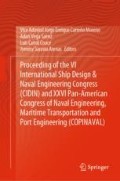Abstract
The conditions of loading in the Maritime Transport are becoming increasingly fundamental and demanding, as the ships increase their size and the efforts begin to travel through the limits of the properties of the materials.
These conditions became critical and require a very demanding control, as loading and unloading operations can collaborate in the collapse of the resistant structure, either by a bending or excessive cutting effort.
In same way of improving the assessment of the stability conditions of the vessel, this work aims to show the new computational development that Arquitectura Naval Asociados is integrating to its platform, which will allow an integral approach by Operators, Ship Owners, Maritime Authorities and Training Institutions as well.
Access this chapter
Tax calculation will be finalised at checkout
Purchases are for personal use only
Notes
- 1.
C is a function of L.
- 2.
C1 is a function of L.
References
Nitta, A., Arai, H., Magaino, A.: Basis of IACS unified longitudinal strength standard. Mar. Struct. 5(1), 1–21 (1992)
Bayraktarkatal, E., Ünsan, Y.: An approximate method for the calculation of shear force and bending moment loading in tankers and bulk carriers. In: Proceedings of the First International Conference on Marin Industry MARIND 1996, vol. III, p. 117 (1996)
Bureau Veritas: Guidance Note for Structural Assessment of Passenger Ships and Ro-ro Passenger Ships, Guidance Note Ni 640 (2018)
Det Norske Veritas: Rules for Classification of Ships; Hull Structural Design Ships with Length 100 Metres and Above (2008)
Det Norske Veritas: Approval and certification of the software of loading computer systems; Class Guide Line, DNVGL-CG-0053 (2016)
Freiria, J., Philippi, E.: eMaster: herramientas para la prevención y predicción de estabilidad de buques. XXV COPINAVAL, Panamá (2017)
Grannemann, F., Bertram, V.: Design of high-performance ships using simulations. Ship Sci. Technol. 3(6) (2009). ISSN 1909–8642
Van-Vu, H.: Prediction the ultimate longitudinal strength of intact ship by finite element method. Int. J. Mech. Eng. Appl. (Special Issue: Transportation Engineering Technology) 3(1–3), 18–23 (2015)
IACS: S11 Longitudinal Strength Standard. International Association of Classification Societies and International Association of Classification Societies (2010). http://www.iacs.org.uk/publications/unified-requirements/ur-s/ur-s11-rev8-cln/
IACS: On Board Use and Application of Computer. International Asociation of Classification Societies. IACS, Londres (2006)
IACS: Recommendations on Loading Instrument. International Asociation of Classification Societies. IACS, Londres (1997)
International Maritime Organization: International Goal - Based Ship Construction Standards for Bulk Carriers and Oil Tankers, Focus on Imo, January 2015
International Maritime Organization: Adoption of the International Goal-Based Ship Construction Standards for Bulk Carriers and Oil Tankers, International Resolution MSC.287 (87). adopted on 20 May 2010
International Maritime Organization: MSC 836, Recommendation on loading instruments. IMO, Londres (2006a)
International Maritime Organization: MSC 854, Guidelines for ship-board loading and stability computer programs. IMO, Londres (2006b)
International Maritime Organization: MSC 891, Guidelines for the on-board use and application of computers. IMO, Londres (2006c)
International Maritime Organization: MSC 1229 Guidelines for the approval of stability instrument. IMO, Londres (2007)
International Organization for Standardization: ISO 16155:2006 Ships and marine technology - Computer applications - Shipboard loading instruments. ISO, Londres (2006)
Lupascu, D., Chirica, I.: Assessment of seagoing ships longitudinal strength in the context of international rules, important factor for safe operation. World J. Eng. Technol. 3, 291–310 (2015)
Author information
Authors and Affiliations
Corresponding authors
Editor information
Editors and Affiliations
Rights and permissions
Copyright information
© 2020 Springer Nature Switzerland AG
About this paper
Cite this paper
Freiria, J., Philippi, E. (2020). eMaster: Ship’s Longitudinal Resistance. In: Carreño Moreno, V., Vega Saenz, A., Carral Couce, L., Saravia Arenas, J. (eds) Proceeding of the VI International Ship Design & Naval Engineering Congress (CIDIN) and XXVI Pan-American Congress of Naval Engineering, Maritime Transportation and Port Engineering (COPINAVAL). CIDIN COPINAVAL 2019 2019. Springer, Cham. https://doi.org/10.1007/978-3-030-35963-8_7
Download citation
DOI: https://doi.org/10.1007/978-3-030-35963-8_7
Published:
Publisher Name: Springer, Cham
Print ISBN: 978-3-030-35962-1
Online ISBN: 978-3-030-35963-8
eBook Packages: EngineeringEngineering (R0)

